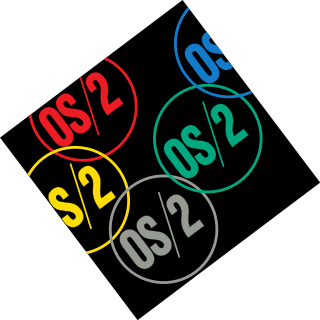
OS/2 is a series of computer operating systems, initially created by Microsoft and IBM under the leadership of IBM software designer Ed Iacobucci. As a result of a feud between the two companies over how to position OS/2 relative to Microsoft's new Windows 3.1 operating environment, the two companies severed the relationship in 1992 and OS/2 development fell to IBM exclusively. The name stands for "Operating System/2", because it was introduced as part of the same generation change release as IBM's "Personal System/2 (PS/2)" line of second-generation personal computers. The first version of OS/2 was released in December 1987 and newer versions were released until December 2001.
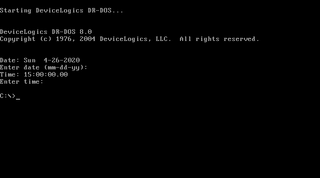
DR-DOS is a disk operating system for IBM PC compatibles. Upon its introduction in 1988, it was the first DOS attempting to be compatible with IBM PC DOS and MS-DOS.
Real mode, also called real address mode, is an operating mode of all x86-compatible CPUs. The mode gets its name from the fact that addresses in real mode always correspond to real locations in memory. Real mode is characterized by a 20-bit segmented memory address space and unlimited direct software access to all addressable memory, I/O addresses and peripheral hardware. Real mode provides no support for memory protection, multitasking, or code privilege levels.

FreeDOS is a free software operating system for IBM PC compatible computers. It intends to provide a complete MS-DOS-compatible environment for running legacy software and supporting embedded systems.

DJ's GNU Programming Platform (DJGPP) is a software development suite for Intel 80386-level and above, IBM PC compatibles which supports DOS operating systems. It is guided by DJ Delorie, who began the project in 1989. It is a port of the GNU Compiler Collection (GCC), and mostly GNU utilities such as Bash, find, tar, ls, GAWK, sed, and ld to DOS Protected Mode Interface (DPMI). Supported languages include C, C++, Objective-C/C++, Ada, Fortran, and Pascal.
In computing, the DOS Protected Mode Interface (DPMI) is a specification introduced in 1989 which allows a DOS program to run in protected mode, giving access to many features of the new PC processors of the time not available in real mode. It was initially developed by Microsoft for Windows 3.0, although Microsoft later turned control of the specification over to an industry committee with open membership. Almost all modern DOS extenders are based on DPMI and allow DOS programs to address all memory available in the PC and to run in protected mode.

In DOS memory management, expanded memory is a system of bank switching that provided additional memory to DOS programs beyond the limit of conventional memory (640 KiB).

In DOS memory management, conventional memory, also called base memory, is the first 640 kilobytes of the memory on IBM PC or compatible systems. It is the read-write memory directly addressable by the processor for use by the operating system and application programs. As memory prices rapidly declined, this design decision became a limitation in the use of large memory capacities until the introduction of operating systems and processors that made it irrelevant.
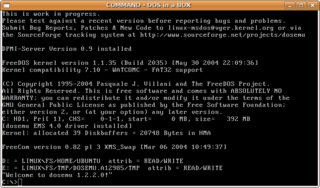
DOSEMU, stylized as dosemu, is a compatibility layer software package that enables DOS operating systems and application software to run atop Linux on x86-based PCs.
Virtual DOS machines (VDM) refer to a technology that allows running 16-bit/32-bit DOS and 16-bit Windows programs when there is already another operating system running and controlling the hardware.
A DOS extender is a computer software program running under DOS that enables software to run in a protected mode environment even though the host operating system is only capable of operating in real mode.
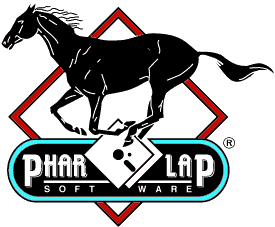
Phar Lap Software, Inc., was a software company specializing in software development tools for DOS operating systems. The company was named after the champion New Zealand racehorse Phar Lap. They were most noted for their software allowing developers to access memory beyond the 640 KiB limit of DOS and were an author of the VCPI standard.

Watcom C/C++ is an integrated development environment (IDE) product from Watcom International Corporation for the C, C++, and Fortran programming languages. Watcom C/C++ was a commercial product until it was discontinued, then released under the Sybase Open Watcom Public License as Open Watcom C/C++. It features tools for developing and debugging code for DOS, OS/2, and Windows, Linux operating systems, which are based upon x86, IA-32, x86-64 compatible processors.
386MAX is a computer memory manager for DOS-based personal computers. It competed with Quarterdeck's QEMM memory manager. It was manufactured by Qualitas.
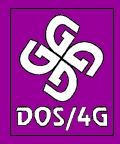
DOS/4G is a 32-bit DOS extender developed by Rational Systems. It allows DOS programs to eliminate the 640 KB conventional memory limit by addressing up to 64 MB of extended memory on Intel 80386 and above machines.
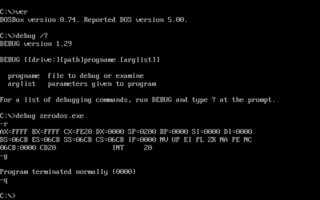
The line-oriented debugger DEBUG.EXE is an external command in operating systems such as DOS, OS/2 and Windows.
The DOS API is an API which originated with 86-DOS and is used in MS-DOS/PC DOS and other DOS-compatible operating systems. Most calls to the DOS API are invoked using software interrupt 21h. By calling INT 21h with a subfunction number in the AH processor register and other parameters in other registers, various DOS services can be invoked. These include handling keyboard input, video output, disk file access, program execution, memory allocation, and various other activities. In the late 1980s, DOS extenders along with the DOS Protected Mode Interface (DPMI) allow the programs to run in either 16-bit or 32-bit protected mode and still have access to the DOS API.
In computing, the Virtual Control Program Interface (VCPI) is a specification published in 1989 by Phar Lap Software that allows a DOS program to run in protected mode, granting access to many features of the processor not available in real mode. It was supplanted by DOS Protected Mode Interface (DPMI) shortly after being introduced, due in large part to VCPI's inability to work in Windows 3.0's protected mode.

DOS is a family of disk-based operating systems for IBM PC compatible computers. The DOS family primarily consists of IBM PC DOS and a rebranded version, Microsoft's MS-DOS, both of which were introduced in 1981. Later compatible systems from other manufacturers include DR-DOS (1988), ROM-DOS (1989), PTS-DOS (1993), and FreeDOS (1998). MS-DOS dominated the IBM PC compatible market between 1981 and 1995.
DOS Protected Mode Services (DPMS) is a set of extended DOS memory management services to allow DPMS-enabled DOS drivers to load and execute in extended memory and protected mode.











